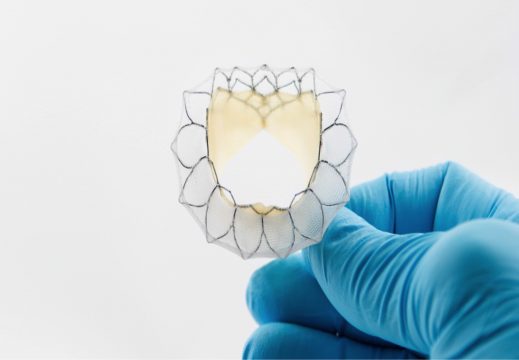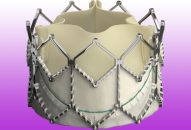Symptomatic mitral regurgitation is associated with high morbidity and mortality that can be alleviated partly by surgical mitral valve replacement. However, many patients do not undergo surgery. Transcatheter mitral valve replacement is an appealing option for this selected patient group. This study aimed to examine the effectiveness and safety of transcatheter mitral valve replacement…
Transcatheter Valve Thrombosis: Predictors, Incidence, and Events
This study sought to clarify the incidence and predictors of hypoattenuated leaflet thickening (assumed as leaflet thrombosis) imaging in transcatheter bioprosthesis. This study involved 70 consecutive patients who underwent transcatheter aortic valve replacement with the Edwards SAPIEN-XT device and were subjected to follow-up at 6 months and 1 year through multislice computed tomography (CT), echocardiographic data, and…
Mitral Annuloplasty with a Cardioband Device: Effective in Functional Mitral Regurgitation
Both surgical and medical treatment options for functional mitral regurgitation are limited. The Cardioband system (Valtech Cardio, OrYehuda, Israel) is a new transvenous, transseptal direct mitral annuloplasty device. This work studied the safety and efficacy of this new device 6 months after implantation. Thirty-one patients with moderate to severe mitral regurgitation associated with severe impairment of the left systolic ventricular…
TAVR vs. Surgery: Valve Performance at Five Years (PARTNER I)
The aim of this study was to evaluate the long-term performance of transcatheter aortic valve replacement (TAVR) and surgically-implanted valves through longitudinal echocardiographic follow-up of the PARTNER I trial patients. The study included all patients receiving TAVR or undergoing surgery who had a post-implant echocardiogram at five years analyzed for peak systolic velocity, mean gradient,…
Post TAVR Cognitive Function at Short Term: Better or Worse?
There is little information on the short and mid-term evolution of cognitive function after transcatheter aortic valve replacement (TAVR). The aim of this study was to describe global changes in cognitive function and changes in specific cognitive domains one year after TAVR. Fifty one patients undergoing TAVR, median age 80, were prospectively followed…
Apixaban: An Alternative for Patients with Atrial Fibrillation Undergoing TAVR?
Courtesy of Dr. Carlos Fava. The prevalence of atrial fibrillation in patients undergoing transcatheter aortic valve replacement (TAVR) is high (32.9%, according to the PARTNER Trial, and 46.8%, according to the CoreValve High-Risk Study), and is associated with thromboembolic events (as in all other populations). Apixaban has shown to benefit patients with nonvalvular atrial fibrillation,…
TAVR in Low-Flow Low-Gradient Aortic Stenosis and Severe Impairment of Systolic Function
Patients with low-flow, low-gradient severe symptomatic aortic stenosis associated with severe impairment of the left ventricular systolic function have shown acceptable outcomes after transcatheter aortic valve replacement (TAVR), according to the multicenter TOPAS-TAVI registry, which demonstrated a relatively low 30-day mortality rate. Considering the very high risk presented by this population involved, a 30-day…
Permanent Pacemaker Predictors with SAPIEN 3
The aim of this study was to identify permanent pacemaker (PPM) predictors after transcatheter aortic valve replacement (TAVR) with last generation balloon expandable valve Edwards SAPIEN 3. The new conduction disturbances requiring PPM are one of the biggest concerns after TAVR, and their predictors have not yet been defined. 229 patients undergoing TAVR…
Paravalvular Leak in Surgical Prosthesis: How to Treat Them
Courtesy of Dr. Carlos Fava. The presence of paravalvular leaks (PVL) after aortic valve replacement ranges between 5% and 20%. Percutaneous repair has emerged as a feasible alternative, effective and safe, to prevent new surgery. The study included 86 patients undergoing aortic valve replacement presenting PVL with cardiac failure CFIII or IV and/or anemia.…
Transcaval Access: Another Alternative to Femoral Access Counterindication
For TAVR eligible patients (transcatheter aortic valve replacement) with femoral access counterindication, a new access site, extra thoracic yet percutaneous, may offer an alternative. This consists of reaching the abdominal aorta through the vena cava. With this technique the operator enters the abdominal aorta through the vena cava by electrifying a guidewire, advancing a…
Coronary Lesions After TAVR: Severity May Be Modified
Courtesy of Dr. Carlos Fava. Between 40% and 70% of patients undergoing transcatheter aortic valve replacement (TAVR) present coronary lesions. The fact that aortic stenosis affects how blockages act, and that, after stenosis correction, hemodynamic compromise for those same lesions may vary, has been consistently proven. Its management has not been determined yet. The study…










